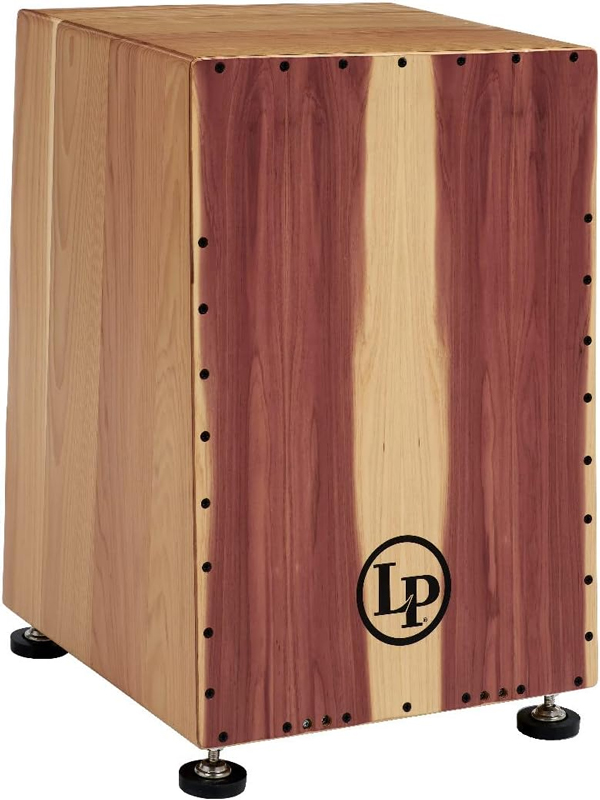(headline image: LP (Latin Percussion) cajón made out of cedar)
The cajón is a Peruvian box drum made from a wooden hollowed box, originally used to store fish or fruit. Typically, the cajón is played using the palms and fingertips. It’s widely used in Afro-Peruvian music and modern flamenco.
Brazilian percussionist Rubem Dantas, a member of Paco de Lucia‘s band, introduced the Peruvian cajón to flamenco audiences in Spain. As a consequence, it became so popular with flamenco performers that it has become an essential percussion instrument in contemporary flamenco ensembles, together with the palmas (handicapping).
Key Features of a Cajón
- Front Panel (Tapa): Made of thinner wood for striking.
- Rear Panel: Includes a circular hole to enhance resonance.
Standard Dimensions for Professional Cajones
- Height: 47 to 50 centimeters
- Width: 28 to 30 centimeters
- Depth: 28 to 30 centimeters
The wood thickness can be up to 15 mm, though 9 mm is becoming more common to reduce weight.
Main Differences Between Peruvian and Flamenco Cajones
The Peruvian cajón and the flamenco cajón are essentially the same instrument. However, there are slight variations in their sound preferences. In Spain, the treble tones are left a bit looser to suit the flamenco style, whereas in Peru, the treble tones are more muted.
Peruvian Cajón:
- Simpler interior
- Deeper sound
- More resonance due to the lack of internal components
- Matte, dry sound
- More direct attack
- Distinct methods of attaching the front panel
Flamenco Cajón:
- Contains guitar strings or snare wires inside
- Strings can be positioned vertically or horizontally in contact with the front panel
- Brighter, more raspy sound
- Diffuse attack

Evolution and Materials
Some consider the flamenco cajón an evolution of the Peruvian cajón, while others see it as a distinct instrument.
Wood Types Used in Cajón Construction
Flamenco Cajón:
- Common Woods: Phenolic birch plywood, birch, oak, and maple.
Peruvian Cajón:
- Common Woods: tornillo (cedrorana), cedar, mahogany, and later mohena (Peruvian walnut) and requia.
Inspired by Afro-Peruvian music and flamenco, many international percussionists in the world music and jazz fields have added the cajón to their percussion collection.
Variations include the cajón flamenco and caja. In Cuba, percussionists made box drums out of fish boxes to make tumbadoras (congas) and other drums.
Prominent Peruvian Cajón Players
Victor “El Gancho” Arciniegas; Carlos “Caitro” Soto; Eusebio “Pititi” Sirio; the Santa Cruz; Campos and Ballumbrosio families; Julio “Chocolate” Algendones; Juan “Cotito” Medrano; Leonardo “Gigio” Parodi; Francisco Monserrate “La Máquina”; Reynaldo Barrenechea; Gerardo Lazón; Aristides Ramirez; Abelardo and Osvaldo Vasquez; Arturo “Zambo” Cavero; María del Carmen Dongo; Alex Acuña; Eduardo Balcazar; Luis Casanova; Fernando Gonzales; Jorge Leturia; Mariano Liy; Freddy Lobatón; Macario Nicasio; Marco Oliveros; Marta Panchano; Leonardo Parodi; Felix Valdelomar; Alfredo Valiente; Pepe Villalobos; Manuel and Juan Carlos Vasquez; Peta and Cata Robles; Moises Zambrano.
Leading Cajón Flamenco Players
The first generation of cajón players in Spain was led by Rubem Dantas (Brazil) who inspired Antonio Carmona (Ketama), Manuel Soler, José A. Galicia “El Gali”, Tino di Geraldo, and Ramón Porrina.
This was followed by several waves of talented players: Israel Suárez “Piraña”; Julio Jiménez “Chaboli”; Horacio “El Negro” Hernández; Paquito González; Antonio Coronel; José Manuel “Bandolero”; Guillermo McGill; “El Guille”, Amador Lozana; Sergio Martinez; Juan Heredia Cortés; Lucky Losada; Grupo Echegaray; Agustín Diassera; Paquito González; Javi Ruibal; Eli Maya; Noelia “La Negri”; Marta Orive; Julián Heredia; Jesus Santiago; Victor Garcia; and Chano Rodríguez.


